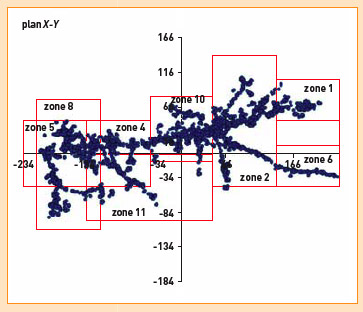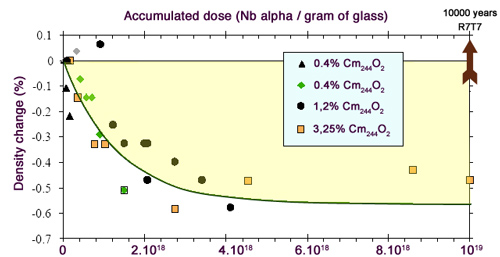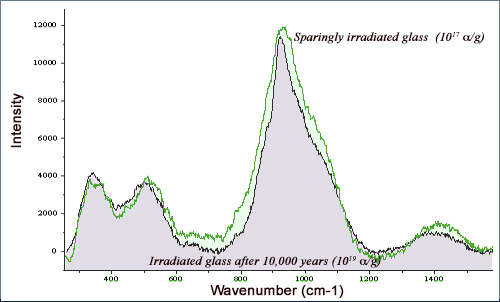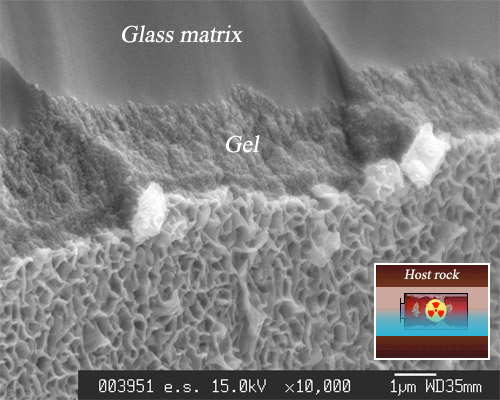Assessing the resistance of vitrified waste over millennia
Is nuclear power a clean industry? To claim that it is would not be very politically correct. And yet, if the materials used to condition the most radioactive materials live up to their promise, it may well be true. Imprisoned in glass, no radioactive atoms would be able to reach our stomachs or lungs for aeons. Such a claim cannot be made for many waste management strategies, but the truth is often slow to be acknowledged…
Scientists and engineers have developed glass to trap the radioactivity in the most radioactive nuclear power plant waste for thousands of years. This borosilicate glass is named R7T7. The international nuclear community considers this silicon- and boron-based glass, manufactured and used in La Hague, to be the best industrial material produced to date for the purpose of confining high-level waste arising out of spent fuel processing operations. Evaluating the resistance of such glass over very long periods is the subject of in-depth research. Greater public awareness of the results obtained would do much to alleviate legitimate concerns and counter prejudice. A clearer understanding of the problems and proposed solutions relating to this radioactive waste would facilitate effective management.

Damage due to nuclei recoil
When an atom decays, its nucleus recoils and the rays emitted inherit some of the energy released. They lose this energy in the form of heat, colliding with the atoms in their environment and displacing them by a few hundred microns. The figure shows a cascade of collisions started by a 70 keV recoil nucleus. The dots correspond to the displaced oxygen atoms. The scales are expressed in angstroms (ten thousandths of microns).
© Clefs CEA N°53
The vitreous matter in R7T7 glass is internally irradiated by fission products and minor actinides, which are the main constituents of vitrified high-level waste. Alpha decays of minor actinides causes atomic displacement within the glass structure, and causes helium to accumulate in the material. How can we guarantee the behaviour of glass designed to remain intact for longer than the entire course of history that separates us from the earliest pharaohs. How can short experiments be used to appropriately assess performance over such long periods? How does the accumulation of disintegrations affect the glass matrix? Does the matrix resist leaching by water? How far can the minor actinide concentration be increased in order to decrease waste volumes?
A research programme has been developed to answer these questions. Engineers and physicists have a variety of tools at their disposal. Very powerful computational tools able to generate highly detailed simulations were developed. The results of these simulations must be compared with the results of laboratory experiments and data obtained from very old naturally-occurring glass.

Slight change of physical properties
Over 10,000 years, a R7T7 vitrified waste package will suffer a 10 to the power of 19 alpha disintegration events per gram. In the laboratory, doses of the same order of magnitude can be accumulated in a few years by doping similar glass specimens with curium-244. The diagram shows that the volume of glass specimens subjected to such irradiation varies by only a small amount, stabilising at a value of 0.6% when 20% of the 10,000-year dose has been received. Other properties, such as the hardness, brittleness and water resistance of the glass follow a similar pattern.
© CEA: « Long-term behavior of vitrified waste packages-« , I. Ribet et al., Global 2009
In experiments, the aim is to subject the glass – within a short time-frame – to a radioactivity test equivalent to what it will actually experience over a period of millennia. One method consists in bombarding thin discs of borosilicate glass with a powerful ion beam (Kr, Au and He ions). By this means, a high irradiation dose is accumulated in a thin layer at the surface of the glass, enabling the effect to be analysed.
An alternative method involves doping borosilicate glass with curium-244. Curium-244 is a highly radioactive minor actinide that decays relatively rapidly (half-life: 18.1 years). Using this technique, a curium-enriched specimen is subjected to as many disintegration events during a 3- to 4-year experiment as in 10,000 years in the standard glass in waste containers intended for deep geological disposal.
By combining simulations and experimental approaches, it has been possible to measure the macroscopic behaviour and structural change of R7T7 glass under the effect of self-irradiation.

Limited changes to the glass structure
The technique of Raman spectroscopy provides information on the molecular structure of a glassy medium, the importance of its alterations. Comparison of a Raman spectrum obtained with a curium-doped glass having undergone a dose equivalent to 10,000 years, allows to estimate the effects of this dose on the structure of the glass. The similarity of the two curves shows that the structure and basic properties of the glass remain largely unchanged.
© CEA: Irradiation Stability of R7T7-Type Borosilicate Glass, S.Peuget et al
The effects at the observed scale are reassuring. The properties of the glass were observed to change slightly owing to alpha decays. Its density decreased slightly and the glass became harder but was not embrittled by the received dose. Above a level of accumulated irradiation representing 20% of the irradiation received over 10,000 years (i.e. 2×10 to the power of 18, or two billion billion disintegrations per gram of glass), a limit appears to be reached, beyond which the properties of the glass do not change any further.
Other changes in the structure of the glass are observed, for instance a decrease in boron atom bonds. A new structure would appear to result from the reorganisation of the glass following ballistic events. The structure of the glass and changes in its macroscopic properties stabilise when all parts of the glass have been damaged by ballistic events.

Water leaching: formation of a protective gel
Degraded vitrified waste packages may be exposed to the effects of water (see inset). The figure shows a scanning electron microscope image of a R7T7 glass specimen degraded by a four-month water immersion at a temperature of 150 C. An outer layer of « phyllosilicates » (precipitated from the solution) can be seen, together with a porous gel formed by in situ condensation; the underlying glass remains undamaged. The high retaining capacity of this gel impedes dispersion of minor actinides. Degradation stabilises unless the water flow is important.
© CEA: « Long-term behavior of vitrified waste packages-« , I. Ribet et al.
Furthermore, the results of these studies did not reveal any specific measurable effects resulting from the production of helium in the glass, up to the maximum dose achieved to date for irradiation over 10,000 years (10 to the power of 19 alpha disintegrations per gram of glass). More generally, the acquired data establishes that the properties of R7T7 glass would not be altered up to that dose, and do not raise any doubts regarding the long-term behaviour of the glass.
TO KNOW MORE ABOUT LONG TERM BEHAVIOUR OF VITRIFIED GLASS:
– 1) : Studies of Long term R7T7 Behaviour
Sources:
« Long-term behavior of vitrified waste packages », I.Ribet et al, Proceedings of Global 2009, 9038
« Irradiation Stability of R7T7-Type Borosilicate Glass », S.Peuget et al, Proceedings of Global 2009, 9254
Learn more :
Conditioning
High-level waste (HLW)
Spent fuel composition
Vitrified waste
Studies of behaviour
Other articles on the subject « Waste Conditioning »
Vitrified High Level Waste
Glass – A very resistant matrix for high-level waste After the uranium and plutonium have b[...]
Conditioning Spent Fuel
Underground disposal of spent fuel – A long-term option Spent fuel assemblies unloaded from react[...]
Packaging Intermediate-level waste
Compaction for hulls and end caps… The zirconium alloy cladding around the uranium oxide pellets [...]
Low and very low level waste
Basic conditioning for low-level and very low-level waste Waste in which the radioactivity is low[...]
Radioactive Waste Containers
Canisters and containers for various types of waste France’s National Evaluation Commission[...]